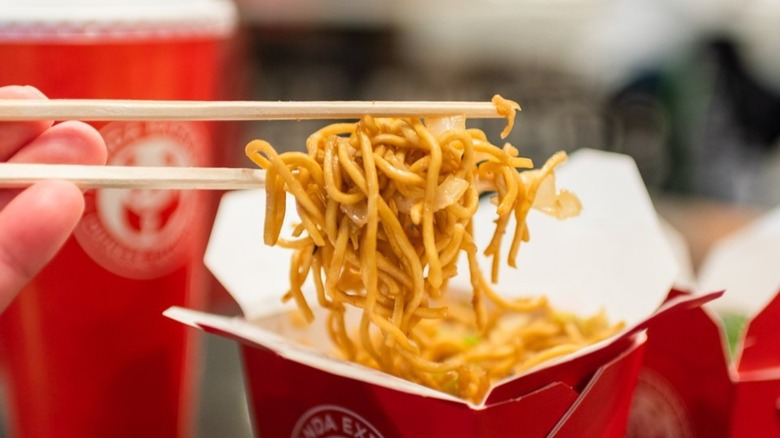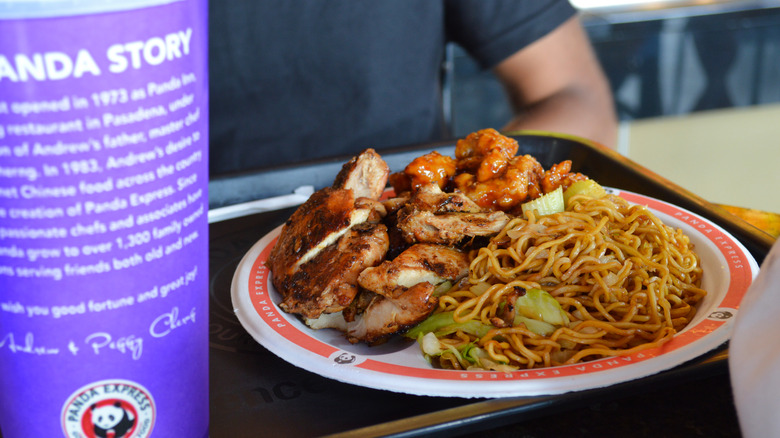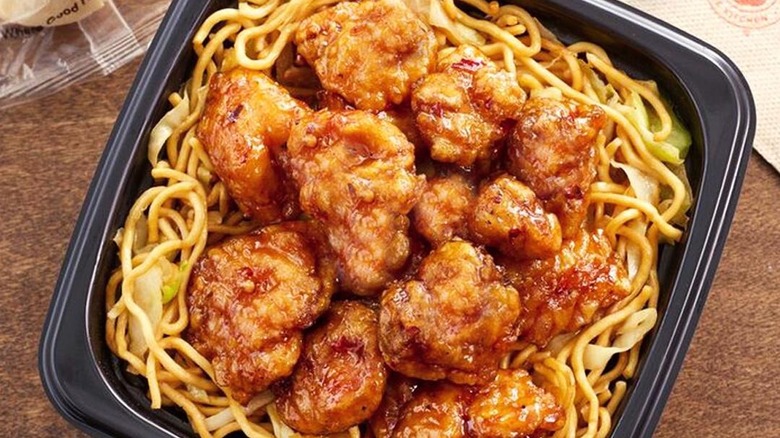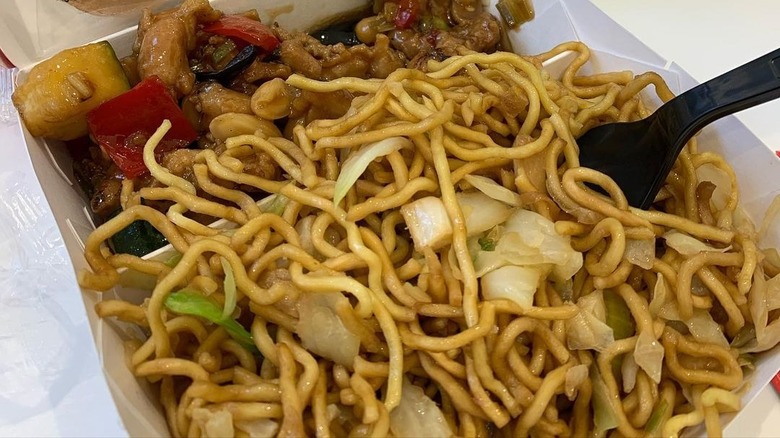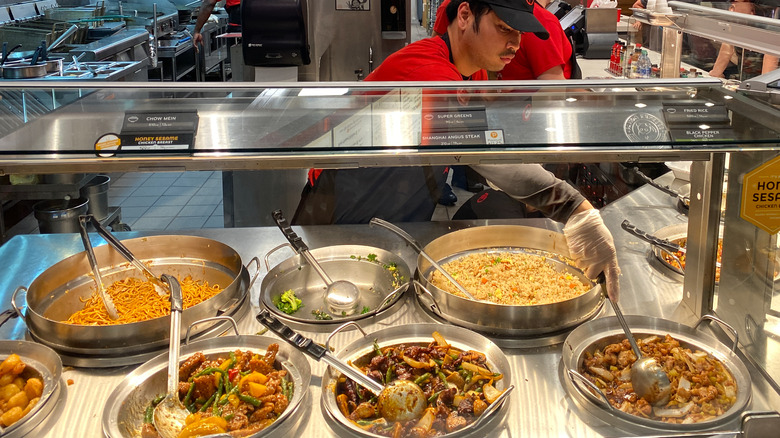Panda Express Chow Mein: What To Know Before Ordering
If you like Chinese food and live in America, chances are you've dined at Panda Express at least once in your life. The restaurant first opened its doors in 1973 under the name Panda Inn. It was started by Andrew and Peggy Cherng, and Andrew's father, Ming-Tsai Cherng. Ming-Tsai was a chef when he lived in China, and brought a master cook's flair to the restaurant's Chinese-American food menu. It wasn't long before Panda Inn became Panda Express, a fast-casual Chinese-American restaurant that today has more than 2,000 locations in the United States alone.
The most popular Panda Express menu item is Orange Chicken. The chain sells 70 million pounds of it each year, and more than half of all Panda Express customers add it to their meal. But there's an unsung hero of the Panda Express menu that pairs perfectly with this signature chicken dish, and we're not talking about rice. It's chow mein.
What is Panda Express Chow Mein?
Though some prefer to pair their entrees with a side of rice, if you want an even more slurpable, savory dining experience, you can ask for chow mein instead. Panda Express makes its chow mein with egg-free wheat noodles (via Panda Express). Traditionally, chow mein noodles usually contain eggs, but perhaps the chain decided to omit them so its menu was more friendly to those with allergies. The noodles are stir fried in soybean oil along with cabbage and celery, which give each bite a bit of crisp-tender crunch. The sauce is made up of sugar, soy sauce, and spices, plus other "proprietary" ingredients not listed online.
The name chow mein can be translated from Chinese to mean "stir-fried noodles," and the chain's rendition pretty much hits the nail on the head. The chow mein at Panda Express is meatless, but it's just as tasty with some orange chicken on top or some broccoli beef tangled up in the noodles as well.
How much does it cost?
Panda Express' chow mein isn't too expensive. But the price can fluctuate depending on how you order it and where you live. According to Panda Express' online ordering system, you can order a Panda Express bowl in Los Angeles with one entree over a bed of chow mein for $6.90. A two-item combo plate with chow mein as the side costs $8.40, while a three-item combo plate with chow mein costs $9.90. A family meal, which comes with three entrees, can be paired with two sides of chow mein for $29 total. There's also a Cub Meal option for kids, which comes with a small side portion of chow mein for $6.10.
You can also order the chow mein a la carte. A medium portion costs $3.40, while a large portion is still less than $5, at $4.40. That makes Panda Express' chow mein an economical choice when you've got a noodle craving that can't be satisfied at home.
How does it taste?
Panda Express chow mein features soft noodles stir-fried with cabbage, onion, and celery, in a slightly sweet and salty soy-based sauce. The cabbage has a slightly sweet flavor and is kept crisp-tender, as is the celery, so you get a bit of crunch with each bite of soft, slippery noodle. Customers online seem to love the Panda Express chow mein. "The way that I crave Panda Express chow mein and orange chicken is borderline sinful," said one fan on Twitter, while another said "I can't trust people that get fried rice from Panda Express over chow mein."
But if you're not a fan of cabbage, it might not be the dish for you. Several people on Twitter and on Reddit noted that there is a lot of cabbage in Panda Express chow mein, with one Redditor even saying "it tastes like I'm eating cabbage with a side of chow mein." Others pointed out that the veggies helped to balance out the refined carbs in the dish, making it a bit healthier.
How to order Panda Express Chow Mein
There are a few different ways to order Panda Express chow mein, but there's one thing you should note: according to employees of the chain on Reddit, you can't customize the noodles, because they're cooked with all of the vegetables and sauce in a big batch. That means, for you cabbage-haters out there, you won't be able to get the noodles without them.
You can enjoy chow mein with your meal at Panda Express in a variety of ways. If you're craving just the chow mein, you can order it a la carte, in a medium or large portion. You can also get it as the base for your bowl, or as the side dish for a combo plate. You can even go half and half, meaning you can get a half order of chow mein as your side dish paired with a half order of a different side to complete your meal.
Is it healthy?
Even if you love chow mein, you may find yourself wondering if it's really so healthy to eat it all the time. Chow mein, after all, features wheat noodles that are boiled, sauteed in oil, and then stirred up with a sweet and salty sauce. The good news is that Panda Express chow mein offers up lots of the fuel you need to power your body each day. A 9.4 oz serving has 6 grams of fiber, 13 grams of protein, 20 grams of fat, and 80 grams of carbohydrates (via Panda Express). In moderation, that's a perfectly reasonable food to enjoy.
Something to watch out for, however, is the amount of sodium. Each 9.4 oz portion of chow mein contains 860 milligrams of sodium, which is more than a third of the 2,300 mg daily sodium limit recommended by the Dietary Guidelines for Americans. The dish also has 3.5 grams of saturated fat, which is something to look out for if your doctor has told you to limit these in your diet. It also contains 9 grams of sugar, which not everyone wants to include in their diet every day.
